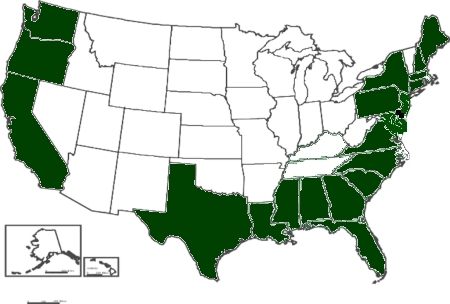Jerusalem Artichoke Native Range
Particularly in the upper Southeast Middle Atlantic and lower Midwestern states where sedimentary rocks underlay the soil. The Jerusalem artichoke Helianthus tuberosus also called sunroot sunchoke wild sunflower topinambur or earth apple is a species of sunflower native to central North America.
Foraging Sunchokes Or Jerusalem Artichokes
Original native territory is difficult to determine but probably extends from Newfoundland to Saskatchewan south to Georgia Tennessee and Arkansas however.

Jerusalem artichoke native range. This perennial flower can take over under-grazed pastures. They need full sun to do well. Jerusalem artichokes are recommended for USDA Agriculture Growing Zones 3 through 9.
Unique Menu with Entrées Mains Desserts in 2 3 5 7 10 course degustation experiences at a Restaurant nestled at the entry to the Eungella Valley. Jerusalem artichokes commonly reach heights of up to 15 feet tall. Native to the central regions of North America the plant can be grown successfully throughout the US.
Jerusalem artichokes grow in zones 3-9. Under a variety of temperature and rainfall regimes. You can grow Jerusalem artichokes to create an inexpensive and quickly growing natural fence to prevent prying eyes on your homestead or prepper retreat.
Jerusalem artichokes are native to North America and have nothing in common with the artichokes found in your local grocery. It is considered weedy in moist moist meadows and valleys in Ontario OMAFRA 2000. Growing Jerusalem artichokes is a little bit like growing potatoes.
They are also known as Jerusalem Artichokes or Sunroots. The plants is a member of the Helianthus genus. The Jerusalem artichoke scientific name Helianthus tuberosus is a species of sunflower native to eastern North America it is also dominantly found in North Dakota Texas Florida and Eastern Canada.
Jerusalem artichokes Helianthus tuberosus grow wild in meadows and along the edges of cultivated fields throughout temperate regions eastern North America. Jerusalem artichoke Helianthus tuberosus L is familiar to many as a weed but has some potential as a crop plant. The tubers are usually sold by the pound and can commonly range.
How To Grow Jerusalem Artichokes. Jerusalem artichoke Helianthus tuberosus also called sunchoke sunflower species Asteraceae family native to North America and noted for its edible tubers. Tuberosus is only occasionally cultivated in the tropics.
Helianthus tuberosus commonly called Jerusalem artichoke sunchoke or sunroot is a type of sunflower which is native to old fields moist thickets forest margins streambanks railroads road margins and open places in North America. Finding the tubers at a larger online garden retailer or Amazon is typically quite easy. Jerusalem artichoke is popular as a cooked vegetable in Europe and has long been cultivated in France as a stock feed.
Other sources presume the original range is southern North America and treat the species as non-native in Canada Scoggan 1979. In these growing areas planting should occur from mid-March through Mid-April. Jerusalem artichokes are not traditionally grown garden crops therefore they may be difficult to locate at a local garden center.
Avoid waterlogged soil since too much moisture is about the only thing that will kill your Jerusalem artichokes. There are both native populations and plants that have escaped cultivation within the state. Jerusalem artichoke tubers boast a higher potassium and fiber count than the majority of other vegetables that are native to North America.
Overall it is a fairly common plant. Jerusalem Artichoke occurs throughout most of Illinois except a few counties in southern and NW Illinois see Distribution Map. It is cultivated widely across the temperate zone for its tuber which is used as a root vegetable.
They are not related to Artichokes but they are related to sunflowers. Despite its name the Jerusalem Artichoke or Sunroot bears no relation to the Globe Artichoke and is actually native to North America where it was cultivated as a food plant by North American Indians. The whole Jerusalem thing is supposedly linked to the Italian word girasola which means sunflower.
Nothings easier than planting a Jerusalem artichoke other than growing them which is even easier. Nowadays it is usually called by the name Sunchokes. Theyre not started from seed but a tuber.
Sunchokes are native to eastern North America.
Growing Jerusalem Artichokes Sunchokes
How To Grow Jerusalem Artichokes Sunchokes Gardener S Path
Growing Jerusalem Artichokes Sunchokes
Jerusalem Artichoke Or Sunchoke Nature S Restaurant A Complete Wild Food Guide Fields Forests Wetlands Foods Of Eastern North America
Jerusalem Artichoke Invasive Species Of Japan
Helianthus Tuberosus Jerusalem Artichoke Maltawildplants Com The Online Flora Of The Maltese Islands
Foraging Sunchokes Or Jerusalem Artichokes
Jerusalem Artichoke Growing Guide
Helianthus Tuberosus Jerusalem Artichoke Minnesota Wildflowers
Jerusalem Artichoke Helianthus Tuberosus Ontario Wildflowers
How To Grow Jerusalem Artichokes Sunchokes Gardener S Path
Helianthus Tuberosus Jerusalem Artichoke Minnesota Wildflowers
How To Grow Jerusalem Artichokes Sunchokes Gardener S Path
Everything You Ever Wanted To Know About Jerusalem Artichokes Aka Sunchokes Aka Helianthus Tuberosus Backyard Forager
Helianthus Tuberosus Jerusalem Artichoke Native Plants Of North America
Jerusalem Artichoke Jerusalem Sunflower Sunchoke Girasole Jerusalem Artichoke Native Plants Wild Flowers
Helianthus Tuberosus Jerusalem Artichoke Minnesota Wildflowers




Post a Comment for "Jerusalem Artichoke Native Range"